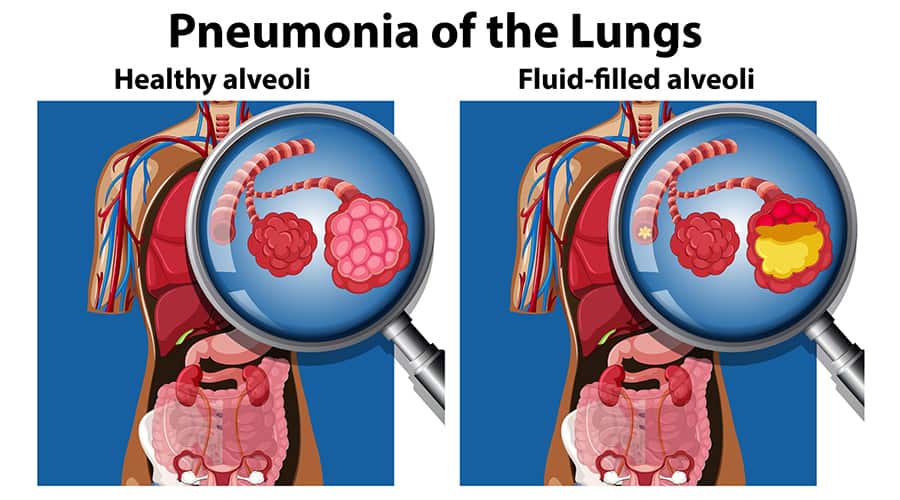
With this new column, Elite Healthcare will compile an index of various infectious diseases, with occasional highlights of emerging conditions.
Pneumonia
General definition and information:
A preventable yet potentially severe condition of the lungs that is responsible for about 50,000 deaths per year in the United States (and is the leading infectious cause of death in children younger than 5 years old worldwide), pneumonia is an infection of one or both lungs that causes the alveoli (air sacs) to fill with fluid or pus. Many factors affect how serious pneumonia is, including the type of germ causing the lung infection, age, and the patient’s overall health. Also especially dangerous to adults older than the age of 65 and those already living with with certain chronic conditions such as heart failure, diabetes, or COPD, HIV/AIDS, and cancer, as well as those who have undergone organ or blood and marrow stem cell transplant procedures. Common symptoms include cough with phlegm, fever, chills, and difficulty breathing. According to the National Heart, Lung, and Blood Institute (NIH), the most common form of the condition is community-acquired pneumonia, with hospital-acquired pneumonia and ventilator-associated pneumonia also forms of the infection.
Causes & Modes of Transmission:
According to the Centers for Disease Control and Prevention (CDC), common causes of viral pneumonia include influenza and respiratory syncytial virus (RSV), a common respiratory virus that usually causes mild, cold-like symptoms. Bacterial pneumonia is commonly caused by streptococcus pneumoniae (pneumococcus). Other infections that commonly cause pneumonia include:1
- human metapneumovirus, a condition discovered in 2001 in the paramyxovirus family along with respiratory syncytial virus;
- human parainfluenza viruses, which typically affect infants and young children;
- the flu;
- Legionnaires’ disease, a serious form of pneumonia caused by swallowing or breathing in of the Legionella bacteria that might be found in water;
- Mycoplasma pneumonia, a type of “atypical” bacteria that commonly causes mild infections of the respiratory system that may be referred to as “walking pneumonia” because its symptoms tend to be mild; and
- Rhinovirus, the most common viral infectious agent in humans and the predominant cause of the common cold.
Smoking, alcohol abuse, and/or being undernourished will also increases the risk for pneumonia, as will poor hygiene habits.
Serious complications of the infection include bacteremia, the spread of an initial infection into the bloodstream, and septic shock. Lung abscesses, pleural effusions (buildup of excess fluid outside the lungs), and pleurisy, a painful condition that occurs when the two layers of the pleura, the thin membranes that line the lungs and the inside of the chest cavity and act to lubricate and facilitate breathing, become irritated and inflamed. Renal failure and respiratory failure are also potential consequences of the infection.
Treatment Strategies:
According to the NIH, treatment for pneumonia will depend on the type of infection, the germ causing the infection, and the severity of the infection. Community-acquired pneumonia is most commonly treatable at home while bacterial pneumonia requires antibiotics and viral pneumonia may resolve with an antiviral medication. Hospitalization may be necessary if symptoms are severe, if there is increased risk for complications due to a patient’s other health problems, and/or the patient’s level of oxygen in the bloodstream is low. Nurses and other healthcare providers should also encourage patients to get plenty of rest, avoid contact with other people, and wash hands frequently. They may also want to order a chest X-ray as symptoms alleviate to ensure the infection is gone.
Prevention Parameters:
The CDC suggests that healthcare providers educate their patients and communities to practice good hygiene as a best practice for prevention. Regular washing of one’s hands and disinfecting frequently touched surfaces will go a long way, as will avoiding smoking and appropriately managing ongoing medical conditions, CDC officials advise. The CDC and other organizations also offer a variety of publications that discuss prevention (and management) strategies for community-acquired pneumonia2,3 and healthcare-associated pneumonia.4-6
References
- Causes of pneumonia. CDC. 2018. Accessed online: www.cdc.gov/pneumonia/causes.html
- Mandell LA, Wunderink RG, Anzueto A, et al. Infectious diseases society of america/American thoracic society consensus guidelines on the management of community-acquired pneumonia in adults. Clin Infect Dis. 2007;44(Suppl 2):S27-72.
- Bradley JS, Byington CL, Shah SS. The management of community-acquired pneumonia in infants and children older than 3 months of age: clinical practice guidelines by the pediatric infectious diseases society and the infectious diseases society of america. Clin Infect Dis. 2011;53(7):e25-76. 31.
- Guidelines library. CDC. 2015. Accessed online: www.cdc.gov/infectioncontrol/guidelines/index.html
- Kalil AC, Metersky ML, Klompas M. Management of adults with hospital-acquired and ventilator-associated pneumonia: 2016 clinical practice guidelines by the infectious diseases society of america and the american thoracic society. Clin Infect Dis. 2016 Sep 1;63(5):e61-e111.
- Klompas M, Branson R, Eichenwald EC, et al. Strategies to prevent ventilator-associated pneumonia in acute care hospitals: 2014. Infect Control Hosp Epidemiol. 2014;35(8):915-36.





